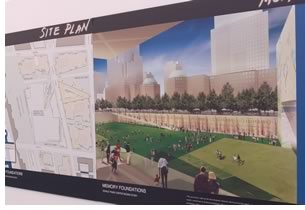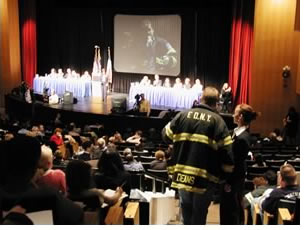

Firefighters and Architects
Address WTC Memorial Jury
Thousands register for design competition
More than 13,000 people hailing from all 50 states and 94 countries registered for the World Trade Center memorial competition, redevelopment officials announced last week. Planners said that at the close of registration May 29, the final number of registrants far exceeds that of any other design competition in U.S. history. Comparatively, about 2,500 registered for the Pentagon memorial competition.
Newsday reports that 4,598 people from New York registered, more than any other jurisdiction. California followed with 1,151 and New Jersey with 922 registrants. Of course, not all who registered will follow through and submit designs, which will be evaluated by a 13-member jury in a two-stage competition. A little fewer than half of the registrants submitted designs for the Pentagon memorial that met competition guidelines; 4,800 registrants of the Oklahoma City memorial competition yielded 627 submissions.
The competition guidelines call for a memorial in the 4.7-acre area architect Daniel Libeskind set aside in the bathtub of the original towers. The LMDC has said the jury will select five finalists this summer and announce a winning design in the fall.
 Listening
to the public
Listening
to the public
“What would you like the memorial to mean for future generations?”
was the opening question posed by Kevin Rampe, interim president of the
Lower Manhattan Development Corporation (LMDC) at a public hearing with
World Trade Center memorial jurors, reports Fredric Bell, FAIA, executive
director of the AIA New York Chapter. The May 28 event, Bell notes, was
the only chance for the public to address the 13-member jury, which includes
architects Maya Lin; Enrique Norten, Assoc. AIA; and Michael Van Valkenburgh,
AIA.
The forum elicited comments from firefighters, family members, architects, and activists. Before the public comment period, the jurors explained their aspirations and motivation for serving on the jury. Lin pledged, “To help find a design that talks to all of us and brings us together as a community.” Susan Freedman, president of the Public Art Fund, said, “It is a very humbling task to approach this and an awesome responsibility to choose something that goes beyond our intellectual understanding ... that will elicit a visceral response that will feel right.” And juror James Young, a Holocaust studies and memorial expert, summed up jury expectations by concluding, “A meeting like this forms the core of the memorial process. The stories we will hear tonight form the stories of the memorial. We will find a place to come to remember.”
 Many
in the audience then had the opportunity to speak, for a maximum of three
minutes. Patricia Riley, representing the Coalition of 9/11 Families spoke
first, asserting that, “We want to preserve from bedrock to infinity
the sacred ground of the site defined by the slurry wall." Jason
Gordon came from Boston to instruct the jury to, "Choose a memorial
that is engaging, that is incapable of receding into the background, to
choose a memorial that is iconic." Many firefighters spoke of the
need for a recognition of the heroism that distinguished their comrades’
efforts that day. Lt. Tom McGuff of Brooklyn’s Engine Company 217
spoke of two firefighters from his company, Steve Copley and Neil Levy,
who died in the WTC. He stressed that he wanted “their names to
go up with FDNY EC217 next to their names.” Similar sentiments were
expressed by many others through the course of the hearing.
Many
in the audience then had the opportunity to speak, for a maximum of three
minutes. Patricia Riley, representing the Coalition of 9/11 Families spoke
first, asserting that, “We want to preserve from bedrock to infinity
the sacred ground of the site defined by the slurry wall." Jason
Gordon came from Boston to instruct the jury to, "Choose a memorial
that is engaging, that is incapable of receding into the background, to
choose a memorial that is iconic." Many firefighters spoke of the
need for a recognition of the heroism that distinguished their comrades’
efforts that day. Lt. Tom McGuff of Brooklyn’s Engine Company 217
spoke of two firefighters from his company, Steve Copley and Neil Levy,
who died in the WTC. He stressed that he wanted “their names to
go up with FDNY EC217 next to their names.” Similar sentiments were
expressed by many others through the course of the hearing.
Ongoing public participation is crucial
Bell said that the civic and architecture communities were represented
by Michael Kuo speaking extemporaneously about his father, who perished
on 9/11, and the planning imperative that motivated Imagine New York and
the Municipal Art Society. Kuo said that Imagine New York will conduct
workshops this fall on the issue raised by the five finalists. Bell spoke
for his component and New York New Visions, a pro-bono coalition of design
organizations, addressing the linkage of memorial and site-design issues
of engagement, connectivity, arrival, spirit, and unity. Read Bell's testimony.
![]()
Landscape architect Diana Balmori, speaking on behalf of the Civic Alliance, Imagine New York, and New York New Visions, emphasized the points the three organizations expected the jury to take into consideration, including ongoing public participation in the memorial process. She concluded with a quotation translated from Antoine de Saint Exupéry’s “Citadel”: “If you want to build a ship, don't tell your people to cut trees, to make planks, and to put them together. Rather give them the yearning for the vast and infinite sea.”
Copyright 2003 The American Institute of Architects.
All rights reserved. Home Page ![]()
![]()
 |
||
| A Web-cast of the forum is available for viewing via LMDC’s Web site. The LMDC will continue to accept comments online and notes that it is also conducting targeted outreach to family members and Lower Manhattan community groups and organizations, ensuring that all residents, businesses, workers, and survivors have an opportunity to share their views on the memorial. Read the testimony submitted by New York New Visions.
|
||